Excerpts from Jim Conrad's
Naturalist Newsletter
from the January 8, 2017 Newsletter issued from Rancho Regensis north of Valladolid, Yucatán, MÉXICO;
elevation ~40m (~130 ft), N~20.876°, W~88.170°
GUANÁBANA FLOWERS & FRUITS
Our Guanábana trees, sometimes called Soursops, are both flowering and fruiting. Guanábanas are members of the Custard-Apple Family, the Annonaceae, along with the wonderful tropical fruits variously known as Custard-Apples, Sweetsops, Sugar-Apples, Cherimoyas -- all of the genus Annona -- and the US's Papaws. The family is closely related to the North's Magnolia Family.
Below, you can see what our Guanábanas look like hanging on a tree:
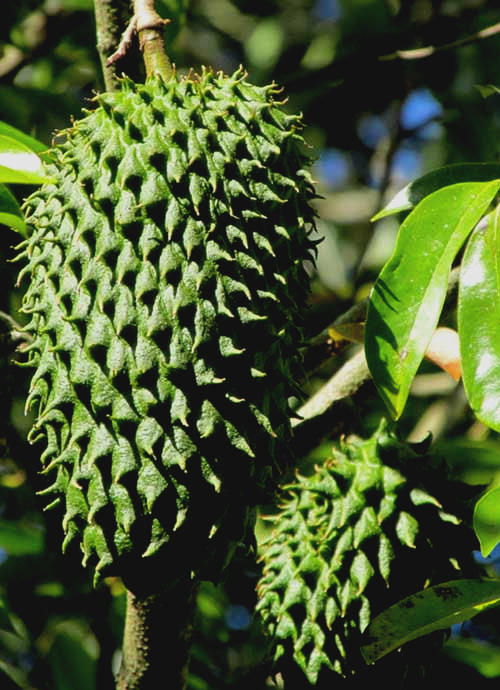
The fruits can be a foot or more long.
Even as the fruits are maturing, flowers are appearing, and it's interesting to see how such spiky fruits can develop from single flowers. It's also interesting that for a long time I've been looking for what I think of as an open blossom, but so far I've never seen one. Our trees' flowers are about 1½ inch long (38mm) and their three leathery sepals just barely crack open, as shown below:
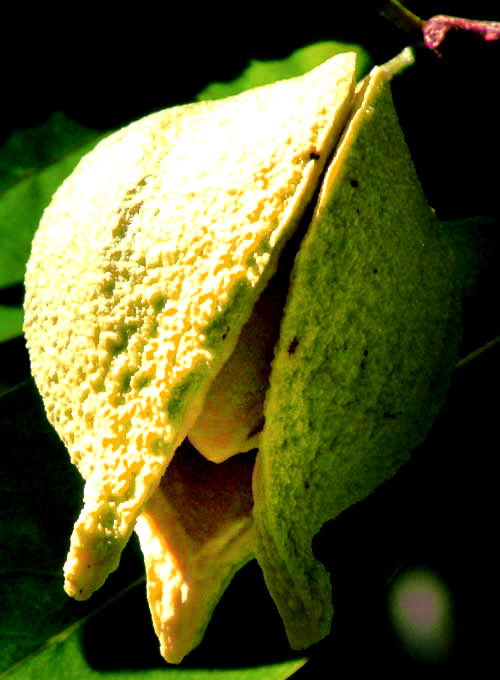
The rancho's Maya workers tell me that they haven't seen more open Guanábana flowers, either. Remembering how widely closely related magnolia flowers open, this surprises me. In the above picture the pale item peeping from inside the sepals' enclosure is one of the flower's yellowish white petals, of which there are six. If you break away one of the three big sepals and a big petal, you can see what's embraced by the overarching petals, shown below:
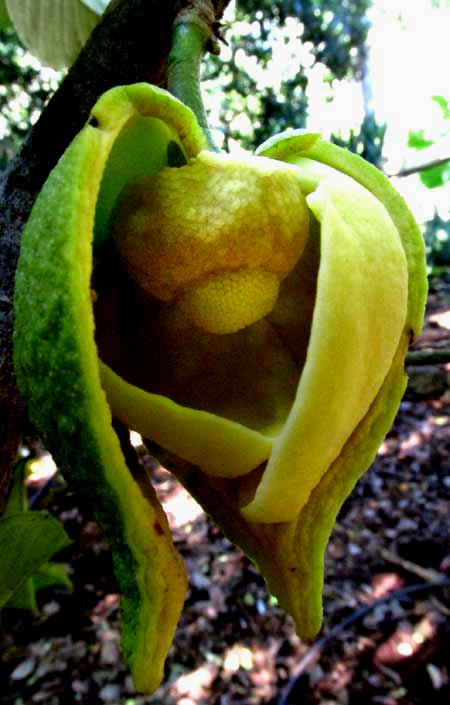
The fuzzy-looking top of the ±spherical item inside the petals is composed of very many stamens -- the flower's male, pollen-producing parts. The lower, paler part of the sphere, like a little yellow face peeping from beneath a Russian fur hat, are many stigma heads -- the female parts where pollen grains germinate after pollination. Apparently the stamens mature first, shed their pollen, and then later the stigma heads mature. Having male and female sexual parts mature at different times keeps a blossom from pollinating itself.
When such flowers are shaken or barely touched, they fall apart, leaving what's shown below:
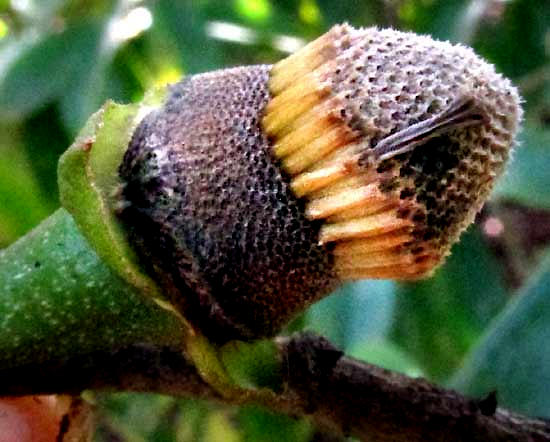
In that picture, the crammed-together items at the right of the picture are the pistils with purplish stigma heads. The grainy, dark area to the lower, left of the pistils is a zone of scars left behind by stamens, which already have matured and fallen off. Keep in mind that those packed-together pistils will merge to become the spiny guanábana fruit. That's easier to believe when you find a flower with the pistils more developed, as shown below
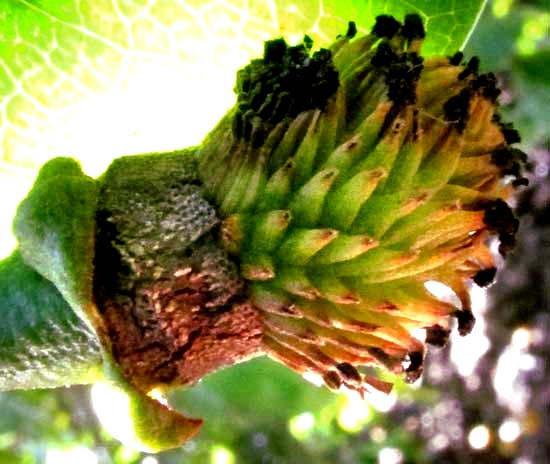
Just visualize those little banana-like things, the pistils, merging together and growing, and that's your future guanábana.
Our tree is littered below with old, decaying guanábana fruits filled with seeds. Below, you can see a small part of a broken-open fruit showing some seeds
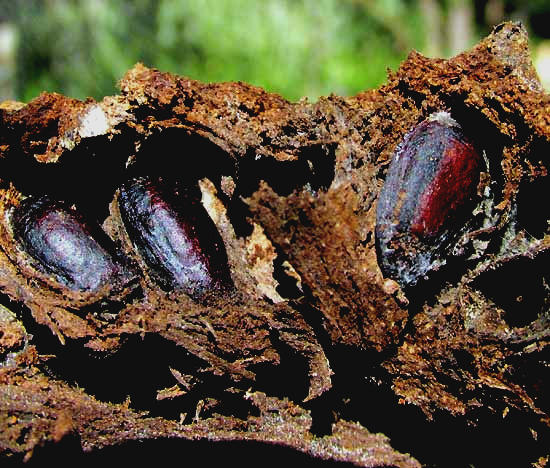
There you can see that one seed lies below each of the fruit's spines, so guanábana fruits are definitely full of seeds. My books say that guanábana fruits are a little acid and that instead of being eaten by themselves, normally they're squashed and squeezed to make tasty drinks, jellies and conserves. This is news to my Maya friends, who say that the fruits are sweet and eaten raw, just that when you eat them you have to spit out lots of seeds.
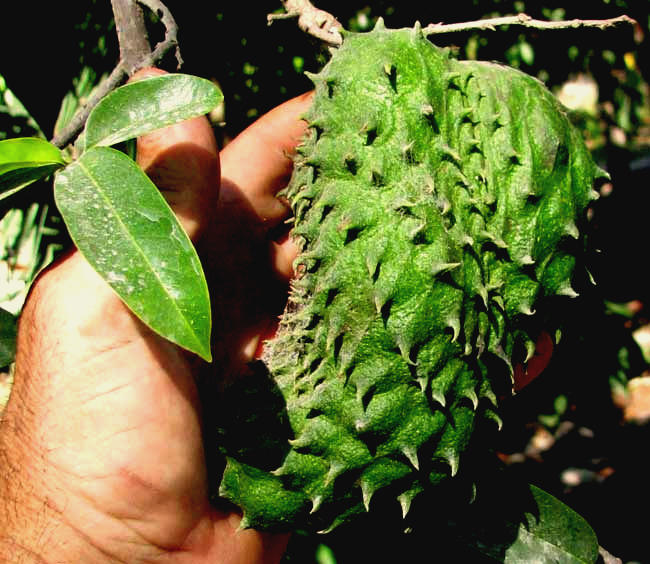
from the April 24, 2011 Newsletter issued from Hacienda Chichen Resort beside Chichén Itzá Ruins, central Yucatán, MÉXICO; limestone bedrock, elevation ~39m (~128ft), ~N20.676°, ~W88.569°
SOURSOPS APPEARING
Fairly commonly seen both along Pisté's backstreets and here at Hacienda Chichen are trees about ten feet tall (3 m) bearing curious fruits like the one shown above.
Wikipedia's page for this species list about 56 common names for it in 15 languages, indicating that here we're dealing with one of the tropics' most planted and therefore most appreciated fruit trees. The most commonly used English name for it may be Soursop. In Spanish it's often called Guanábana. It's ANNONA MURICATA, a member of the Custard-Apple or Anona Family, the Annonaceae.
We've run into the genus Annona before -- species that always were trees bearing deliciously sweet fruits. Back in Chiapas we met the Cherimoya, whose page is at www.backyardnature.net/chiapas/anona.htm.
In Sabacché here in the Yucatán we met the Sweetsop, at www.backyardnature.net/yucatan/sweetsop.htm.
Fruits of all three species are juicy and sweet, but also they all contain large, hard seeds that require a lot of spitting when you eat the fruits. All the fruits also are somewhat bumpy, though none is as rough-surfaced as our present Soursop. The bumpiness results from the flower's architecture.
Each Annona flower contains several pistils, a pistil being the flower's female part, composed of a stigma, style and ovary. As the flower matures, the male parts and the calyx and corolla fall off, leaving the several pistils to enlarge and fuse together with one another as well as with the vegetative platform holding the pistils, the receptacle. So, when we eat fruits of the genus Annona, we're eating fused- together pistils and receptacle. Resulting fruits are known as "syncarps."
Soursops are called Soursops because the fruits are acidy -- also juicy, whitish and fragrant. While the other Annonas we've seen are mainly eaten fresh, Soursops seem to be used mostly for making sweetened, fruity drinks. They can also be made into preserves. Traditionally the juice has been considered a remedy for dysentery.
This is another native Mexican species that, because of its desirable fruits, has been planted in tropics worldwide.
In the forested eastern United States the most notable species in the Custard-Apple Family is the Pawpaw, Asimina triloba, with similarly sweet, juicy fruits. Though Pawpaw fruits aren't bumpy or toothed like Annonas -- they're formed from separate pistils NOT fused together -- you can convince yourself that Pawpaws and Annonas are closely related by comparing the twigs' buds. The buds of both species are "naked," bearing no scales. At the tips of branches, their buds are nothing more than tiny, overlapping, folded leaves covered with rusty hairs, as shown below:
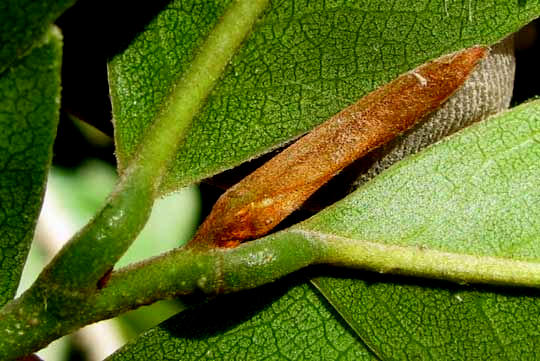
That's a Soursop bud, looking very much like a Pawpaw bud.